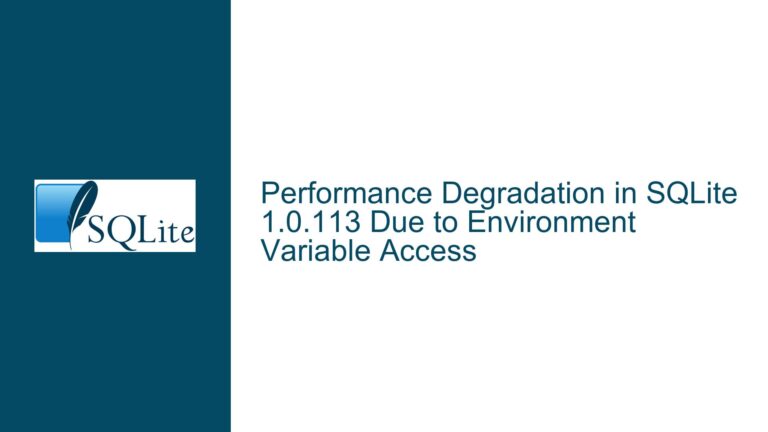and Preventing Unnecessary Subquery Evaluation in SQLite CTEs
Issue Overview: Unnecessary Evaluation of CTE Subqueries in Conditional Logic
In SQLite, Common Table Expressions (CTEs) are a powerful tool for organizing complex queries into modular, readable components. However, a common issue arises when CTEs are used in conditional logic, where the query planner may evaluate subqueries unnecessarily, even when the conditions suggest they should not be executed. This behavior can lead to significant performance degradation, especially when dealing with large datasets or expensive operations.
The core issue in this scenario involves a CTE named ts, which is designed to execute only when a specific condition is met (in this case, when the total count of messages is less than 24). However, the query planner evaluates the ts CTE regardless of the condition, leading to unnecessary computation. This behavior is counterintuitive, as one would expect the query planner to optimize the execution path based on the conditional logic.
The problem is exacerbated by the presence of an ORDER BY clause within the ts CTE, which forces SQLite to sort the entire dataset before applying any limits or conditions. This sorting operation is computationally expensive, particularly when the dataset is large. The addition of a LIMIT 24 clause significantly speeds up the query, but this is a workaround rather than a solution, as the ts CTE should not be evaluated at all when the condition is not met.
Possible Causes: Query Planner Behavior and Subquery Flattening Limitations
The unnecessary evaluation of the ts CTE can be attributed to several factors related to SQLite’s query planner and its handling of subqueries and CTEs.
Query Planner Optimization Limitations: SQLite’s query planner is designed to optimize queries based on available indexes, statistics, and heuristics. However, it may not always recognize that a CTE or subquery can be skipped based on conditional logic. In this case, the query planner evaluates the
tsCTE because it does not see a direct dependency between the condition (tc < 24) and the CTE itself. The planner assumes that all rows from thetsCTE need to be evaluated before applying theWHEREclause, even though the condition could theoretically prevent the CTE from being executed.Subquery Flattening Constraints: SQLite employs a technique called "subquery flattening" to optimize queries by merging subqueries into the main query where possible. However, this optimization is not always applicable, especially when the subquery contains complex operations like
ORDER BYorLIMIT. In this scenario, theORDER BYclause in thetsCTE prevents subquery flattening, forcing SQLite to evaluate the entire CTE before applying the condition.Conditional Logic Evaluation Order: SQLite evaluates conditions in the
WHEREclause after generating the result set from the CTEs. This means that thetsCTE is evaluated first, and only then is the condition (tc < 24) applied to filter the results. This evaluation order is not ideal for performance, as it requires the CTE to be fully evaluated even when the condition would render its results irrelevant.Lack of Lazy Evaluation: Unlike some programming languages that support lazy evaluation (where expressions are only evaluated when needed), SQLite evaluates all parts of a query eagerly. This means that CTEs and subqueries are evaluated regardless of whether their results are ultimately used in the final output. This eager evaluation can lead to unnecessary computation, particularly in conditional queries.
Troubleshooting Steps, Solutions & Fixes: Optimizing Conditional CTE Evaluation
To address the issue of unnecessary CTE evaluation, several strategies can be employed to optimize the query and ensure that the ts CTE is only evaluated when necessary.
Refactor the Query to Use Conditional Logic Within CTEs: One effective approach is to move the conditional logic inside the CTE itself, rather than relying on the
WHEREclause to filter results after the CTE has been evaluated. This can be achieved using SQLite’sIIFfunction orCASEstatements to control the execution path within the CTE. For example:WITH tc AS (SELECT 100 AS tc), message_limit AS (SELECT IIF((SELECT tc FROM tc) < 24, (SELECT COUNT(*) FROM message), 0) AS message_limit), message_all_or_nothing AS (SELECT * FROM message LIMIT (SELECT message_limit FROM message_limit)) SELECT * FROM message_all_or_nothing;In this refactored query, the
message_limitCTE determines the limit based on the value oftc, and themessage_all_or_nothingCTE applies this limit directly. This ensures that themessagetable is only scanned if the condition is met, avoiding unnecessary computation.Avoid
ORDER BYin CTEs When Possible: The presence of anORDER BYclause in a CTE can force SQLite to sort the entire dataset, even if the results are later limited or filtered. If sorting is not strictly necessary, it should be removed from the CTE and applied only in the finalSELECTstatement. For example:WITH tc AS (SELECT 100 AS tc), message_limit AS (SELECT IIF((SELECT tc FROM tc) < 24, (SELECT COUNT(*) FROM message), 0) AS message_limit), message_all_or_nothing AS (SELECT * FROM message LIMIT (SELECT message_limit FROM message_limit)) SELECT * FROM message_all_or_nothing ORDER BY t;Here, the
ORDER BYclause is moved to the finalSELECTstatement, allowing SQLite to apply the limit before sorting, which can significantly improve performance.Use
LIMITto Control Evaluation: Adding aLIMITclause to the CTE can help SQLite optimize the query by reducing the number of rows that need to be evaluated. However, this should be done carefully, as it may change the semantics of the query. In the original query, addingLIMIT 24to thetsCTE speeds up the query because it reduces the number of rows that need to be sorted and evaluated. However, this is not a general solution, as it assumes that the limit is appropriate for all cases.Consider Using Temporary Tables or Views: In some cases, it may be beneficial to use temporary tables or views to precompute results and avoid repeated evaluation of expensive subqueries. For example:
CREATE TEMPORARY TABLE temp_message AS SELECT * FROM message; WITH tc AS (SELECT 100 AS tc), message_limit AS (SELECT IIF((SELECT tc FROM tc) < 24, (SELECT COUNT(*) FROM temp_message), 0) AS message_limit), message_all_or_nothing AS (SELECT * FROM temp_message LIMIT (SELECT message_limit FROM message_limit)) SELECT * FROM message_all_or_nothing ORDER BY t;By creating a temporary table, the
messagetable is only scanned once, and the results can be reused in subsequent queries. This approach is particularly useful when the same data is needed in multiple queries or when the data does not change frequently.Analyze the Query Plan: Understanding how SQLite’s query planner is executing the query can provide valuable insights into potential optimizations. The
EXPLAIN QUERY PLANstatement can be used to analyze the query plan and identify bottlenecks. For example:EXPLAIN QUERY PLAN WITH tc AS (SELECT 100 AS tc), message_limit AS (SELECT IIF((SELECT tc FROM tc) < 24, (SELECT COUNT(*) FROM message), 0) AS message_limit), message_all_or_nothing AS (SELECT * FROM message LIMIT (SELECT message_limit FROM message_limit)) SELECT * FROM message_all_or_nothing ORDER BY t;The output of this statement will show how SQLite is executing the query, including which indexes are being used and how the CTEs are being evaluated. This information can be used to identify areas where the query can be optimized.
Use Indexes to Optimize Data Access: Ensuring that the
messagetable has appropriate indexes can significantly improve query performance. For example, if thetcolumn is frequently used inORDER BYorWHEREclauses, an index on this column can speed up sorting and filtering operations. The following statement creates an index on thetcolumn:CREATE INDEX idx_message_t ON message(t);With this index in place, SQLite can retrieve and sort the data more efficiently, reducing the need for expensive full-table scans.
Consider Alternative Database Designs: In some cases, the issue may be rooted in the database schema design rather than the query itself. For example, if the
messagetable contains a large number of rows and the query frequently filters based on thetcolumn, it may be beneficial to partition the table or use a different data structure. SQLite supports table partitioning through the use of attached databases or by manually splitting the data into multiple tables.Evaluate the Use of Triggers or Stored Procedures: For more complex scenarios, triggers or stored procedures can be used to precompute results or enforce business logic. While SQLite does not support stored procedures in the same way as other databases, triggers can be used to automatically update summary tables or enforce constraints. For example, a trigger could be used to maintain a count of messages in a separate table, which could then be used in the query to avoid recalculating the count each time.
By applying these strategies, it is possible to optimize the evaluation of CTEs in SQLite and ensure that subqueries are only executed when necessary. This not only improves query performance but also makes the code more maintainable and easier to understand.





